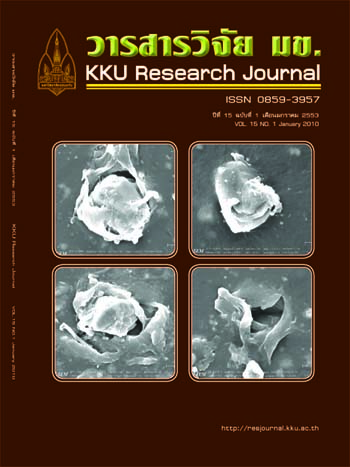Effects of CaCO3 content and stretching ratio on PE film properties
Main Article Content
Abstract
This research studied the effects of variables on the properties of low density polyethylene (LDPE) film. These variables were the portion of calcium carbonate (CaCO3 ) in PE and the stretching ratio of the PE film forming. The portion of CaCO3 in the range of 0-50 % (by weight) was mixed with PE, then processed to be a thin PE film by a blown film extruder at different stretching ratio (i.e. 100%, 135%, 150% and 170%). Properties of these PE film, such as tensile strength and elongation at failure, water vapor transmission rate (WVTR), oxygen transmission rate (OTR) and fractured surface of the PE film under scanning electron microscopy (SEM), were determined. The results showed that when the portion of CaCO3 was increased it increased both the water vapor transmission rate and oxygen transmission rate, while reduced the tensile strength and elongation at failure. Increasing the stretching ratio of the PE film forming also increased both the water vapor and oxygen transmission rate. For the film containing the same portion of CaCO3 , increasing the stretching ratio resulted in the increase in tensile strength. The results of scanning electron microscopy confirmed that the distribution of CaCO3 particles was uniformed. The stretching ratio during film formation affected the pore size around CaCO3 particles, since the area of pore would increase when the stretching ratio increased.
Article Details
How to Cite
Tanboonchuy, V., & Kajorncheappun-ngam, S. (2017). Effects of CaCO3 content and stretching ratio on PE film properties. Asia-Pacific Journal of Science and Technology, 15(1), 1–8. retrieved from https://so01.tci-thaijo.org/index.php/APST/article/view/83135
Section
Research Articles

